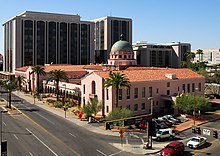Roy Place: Difference between revisions
| Line 21: | Line 21: | ||
*Mansfeld Junior High School (1930) |
*Mansfeld Junior High School (1930) |
||
*Reilly Funeral Home (late 1920's/early 30's Art Deco remodel) |
*Reilly Funeral Home (late 1920's/early 30's Art Deco remodel) |
||
*Cochise County Courthouse in [[Bisbee, Arizona|Bisbee]] (1930): |
*Cochise County Courthouse in [[Bisbee, Arizona|Bisbee]] (1930): A rare example of Pueblo Deco architecture. |
||
*U.S. Post Office. [[Yuma, Arizona]] (1933): 370 West Third Street. Yuma, Arizona. |
*U.S. Post Office. [[Yuma, Arizona]] (1933): 370 West Third Street. Yuma, Arizona. |
||
*University of Arizona Humanities Building (1935) |
*University of Arizona Humanities Building (1935) |
||
| Line 31: | Line 31: | ||
*University of Arizona Administration Building (1937) |
*University of Arizona Administration Building (1937) |
||
*[[Benedictine Sisters of Perpetual Adoration|Benedictine Sanctuary]] (1939-1940) (http://www.tucsonmonastery.com) |
*[[Benedictine Sisters of Perpetual Adoration|Benedictine Sanctuary]] (1939-1940) (http://www.tucsonmonastery.com) |
||
*Tucson Unified School District Educational Building (1941) 1010 East 10th Street; An example of Pueblo Revival. |
*Tucson Unified School District Educational Building (1941) 1010 East 10th Street; An example of [[Pueblo Revival]] architecture. |
||
*Bank Building; 150 N. Stone Ave. (1955) Tucson, Arizona. |
*Bank Building; 150 N. Stone Ave. (1955) Tucson, Arizona. |
||
*Arizona School for the Deaf and Blind. |
*Arizona School for the Deaf and Blind. |
||
Revision as of 15:03, 3 September 2009
Roy W. Place (1887 – 1950) was a Tucson, Arizona architect.
Born in San Diego in 1887, Place moved to Tucson in 1917 after working in Chicago and the Boston firm of Sheply, Rutan and Coolidge. Place partnered with John Lyman in 1919, together constructing over 20 buildings in Tucson. Place worked independently from 1924-1940 as the University of Arizona's Chief architect. Roy’s son, Lew Place, joined the firm in 1930, became a partner in Place and Place in 1940, and managed the firm after his father’s death. Lew Place designed several University of Arizona buildings as well as Pueblo, Rincon and Salpointe High Schools. Lew was also the sculptor for the two figures on the Cochise County Courthouse. [1]

Place’s sophisticated Spanish Colonial Revival building shaped the character of Downtown Tucson from the mid 1920s until urban renewal of the late 1960s and early 1970s. Buildings included the Plaza Theater constructed in 1930 (closed and demolish on May 14, 1968 for the widening of Congress Street), the Montgomery Ward Building (striped and resurfaced on the corner of Pannington and Stone Avenue) and The Pioneer Hotel (refaced and striped of its ornamentation). The domed and pink plaster Pima County Courthouse is Place’s only extant surviving example of this architectural style in the downtown Tucson.
The never realized ‘“Puelo Nuevo Lodge”’ was designed by Roy Place and developer G.G. Souerbry. Conceived as a grand, pueblo revival, courtyard, luxury 24 units apartment Co-Op. The site occupied a Tucson city block on Speedway Boulevard from Martin to Warren. The elegant two story design featured courtyards, pueblo massing and environmentally sensitive details. Each unit was conceived with a second story bedroom with two porches to maximize open air sleeping. The development was advertised as the “most beautiful and attractive ever constructed in Tucson” and was to feature: Philippine mahogany trim, colored stucco walls, steel casement windows, celotex insulation, bean ceilings, tile, oak and linoleum floors and kitchen servidors.
Extant Buildings
- Hotel Congress (1919)(NOTE: Alexander Curlett and Son, Los Angeles, is the architect of record for Hotel Congress (as well as the Rialto) in its National Registration listing.)
- Roskruge School (date unknown)
- Sam Hughes Elementary School (1927) (http://edweb.tusd.k12.az.us/Sam_Hughes/)
- Pioneer Hotel (1928)
- Pima County Courthouse (1929) (http://jp.pima.gov/Pages/history/buildings.htm)
- Veterans Administration Hospital (1929)
- Former Montgomery Ward Building (1929) (http://www.downtowntucson.org/downtowntucsonan/feb05/historic.html)
- El Conquistador Water Tower (1929)
- Mansfeld Junior High School (1930)
- Reilly Funeral Home (late 1920's/early 30's Art Deco remodel)
- Cochise County Courthouse in Bisbee (1930): A rare example of Pueblo Deco architecture.
- U.S. Post Office. Yuma, Arizona (1933): 370 West Third Street. Yuma, Arizona.
- University of Arizona Humanities Building (1935)
- University of Arizona Anthropology Building (1935)
- University of Arizona Chemistry-Physics Building (1936)
- University of Arizona Centennial Hall (1936-1937)
- University of Arizona Gila Hall (1937)
- University of Arizona Yuma Hall (1937)
- University of Arizona Administration Building (1937)
- Benedictine Sanctuary (1939-1940) (http://www.tucsonmonastery.com)
- Tucson Unified School District Educational Building (1941) 1010 East 10th Street; An example of Pueblo Revival architecture.
- Bank Building; 150 N. Stone Ave. (1955) Tucson, Arizona.
- Arizona School for the Deaf and Blind.
- Former Sears & Roebuck, 81 N. 6th Avenue (1929; remodel and addition 1940 (demolished 1984), and 1947 south wing addition (existing)); An example of Art Deco.
Demolished Buildings
- Plaza Theater (Tucson) (1930)
References
- Haldeman, Peter. Architectural Digest, October 2004: www.ronstadt-linda.com/ad2004.html
- Nequette, Anne M. and Jeffery, R. Brooks. A Guide to Tucson Architecture. University of Arizona Press 2002.
- Cooper, James F. The First Hundred Years: The History of Tucson School District 1, Tucson Arizona 1867-1967: http://www.tusd.k12.az.us/contents/distinfo/history/history.html
- Copper, James F. Places in the Sun. Westernlore Press, Tucson 1989.
- The University of Arizona Comprehensive Campus Plan: Appendix 5 List of Historic Buildings: http://www.cfp.arizona.edu/PDF_Files/Appendix%205.pdf
